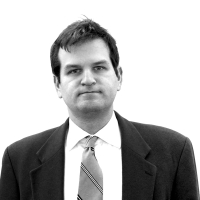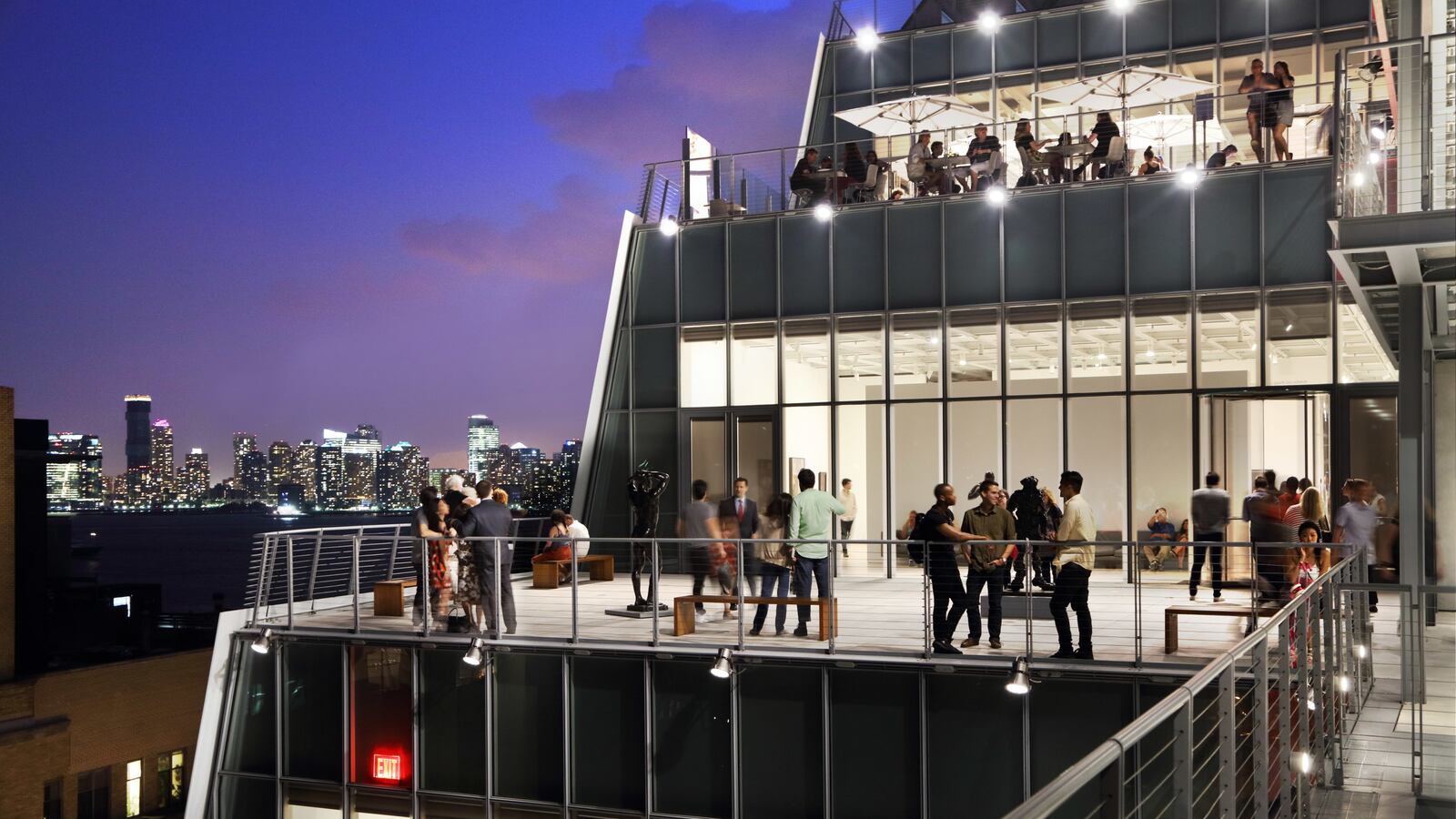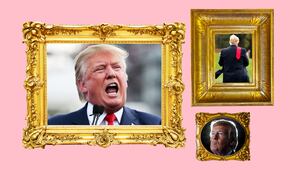It was easy to skip past “Triple Chaser” by Forensic Architecture at the Whitney Biennial. New artwork by emerging and established artists from around the world stretched across multiple floors of the Manhattan museum, most of it eye-catching or spectacular, or at the very least sort of lovely.
“Triple Chaser” is none of these things. It is a video installation produced in part by Laura Poitras, the Academy Award-winning documentary filmmaker behind Citizen Four, about the whistle-blower Edward Snowden, and it is narrated by former Talking Heads frontman David Byrne.
It is not so much a piece of video art as it is of investigative journalism, and it unfolds slowly over 10 minutes, telling the story of how Safariland, a company owned by Warren B. Kanders, who sits on the Whitney’s board and has given more than $10 million to the museum, manufactured tear gas used in conflicts around the world from the Middle East to the U.S./Mexican border.
After weeks of protest, and a threat by some artists included in the Biennial to withdraw from the show, Kanders stepped down from the board, allowing the show to go on with its original roster, and making “Triple Chaser,” a piece that stretches the definitions of art, one of the most significant works to appear in the Whitney or any other museum in years.

Allison Kanders and Warren Kanders attend the 2012 Whitney Gala at The Whitney Museum of American Art on Dec. 11, 2012, in New York City.
Ben Gabbe/GettyIt is the work of Forensic Architecture, an entity that isn’t so much an art collective as it a University of London-based “multidisciplinary research group,” in the words of its founder and leader Eyal Weizman.
Weizman grew up in Israel and trained as an architect, but became involved in human rights and anti-colonial struggles, particularly in Gaza and the West Bank, and began to notice how the occupation wasn’t just driven by governments and militaries but by architects too.
“Architects were locating roads and settlements and infrastructure. They were committing human rights violations too,” said Weizman by phone in Spain, where he was traveling.
“My desire to be an architect was to use architecture as a social and political tool, and I realized that architecture is not about designing buildings. Architecture is a way of seeing the spatial dimensions of relationships of people, of societies, and the way they exist in space. Architecture is a way to analyze a violation of human rights, to unpack the politics in a way that other frameworks are perhaps not.”
Forensic Architecture’s first serious project was an investigation into the killing of an unarmed civilian by the Israeli army near the West Bank barrier wall. Using advanced mapping techniques, the group showed, contrary to the Israeli army’s description of events, that the killing was intentional. Using similar techniques, the group looked into the murder of civilians at the hands of the police in Turkey, Palestine, Greece, Mexico, and elsewhere.
Using the testimony of survivors, the group has built a rendering of secret prisons in Syria, found US military personnel working and living near torture sites in Cameroon, and most notably, using digital models and physical reconstructions, placed a German intelligence agent near the spot where a Turkish immigrant was murdered in a cafe in Kassel, Germany.
Each of the investigations, Weizman says, use new processes and new techniques, and the outcome of each remains unknown when they are begun. The group now has nearly two dozen members, and although they are based in London, they have affiliates and researchers who aid in their investigations all over the world.
Thomas Keenan, the director of the Human Rights Project at Bard College and an occasional collaborator with Forensic Architecture, said that much of the work the group does is an outgrowth of a post-Cold War moment in the understanding of how the conversation around human rights occurs. In the previous century, it was widely believed that merely bringing atrocities to light would help end them. But the world watched on its televisions as there were genocides in both Rwanda and Bosnia in the 1990s.
“Forensic Architecture is a response to that, to try to make more powerful and more persuasive evidence, not just by putting it on TV, but by storytelling, by modeling and visualizing and developing political coalitions,” he said.
In other words, if labeling a human rights violation as such is not sufficient to end the practice, then find other ways to do so.
“They have really multiplied the venues in which the public can learn about human rights violations. They make a coalition between political actors, NGOs, international organizations, artists, filmmakers, architects and others. They have upped the aesthetic game around these claims and picked their battles a lot more carefully than other organizations,” Keenan continued. “I see them not as an art collective but as a 21st century kind of human rights organization.”
“Triple Chaser” was in some respects Forensic Architecture’s most daring work, not for its form so much, which was much more of a work in progress than other group investigations, but for the fact that it took on its host in the form of Whitney board member and patron Kanders.
Weizman said that when they were asked to participate in the Biennial, he knew they would have to take on as a subject Safariland and Kanders.
“I myself have breathed in tear gas that was produced by Kanders and Safariland,” he said. “We came to realize that the art world itself is complicit with human rights violations and political repression we have been investigating. So we decided to make the subject matter the very institution we are working with. We just thought it would be dishonest to use the platform that Kanders is a part of without attempting to inquire into these relationships. We thought the museum would not accept it, and we would have to decline the invitation.”
The curators of the Whitney Biennial, Jane Panetta and Rujeko Hockley, were not available for an interview, and in a response to an emailed list of questions did not answer one related to Kanders directly, but said they invited Forensic Architecture because their work allows “for the production of alternate forms of evidence, which can ultimately be used to unravel larger-scale forms of systemic violence, shedding light on what has been hidden or even denied,” adding that the group’s “emphasis on the visual feels like a key element.
“So often, their research leads with an emphasis on seeing or re-seeing events that have transpired, something they achieve through their use of open source imagery and careful composing of individual frames within their videos. Ultimately, these strategies take on renewed significance in the context of art-making—a space with an inherent and frequent emphasis on relaying information through visual means.”
Kanders' role as owner of Safariland and Defense Technology had been publicized over the last several years by Hyperallergic, an art news and criticism website based out of Brooklyn, New York, and picked up on by the activist museum group Decolonize This Place.
As the Biennial has progressed, calls grew for artists to boycott the show so long as Kanders was on the museum’s board. A half-dozen artists signed on, and then Forensic Architecture eventually joined them. Then, a researcher with the group in Gaza found what was claimed to be an unexploded open-tipped bullet produced by another company partially owned by Kanders, Sierra Bullets, a discovery first reported by the art website Hyperallergic, a finding that eventually led to Kanders to step down from the board.
In a statement, Kanders said, “The targeted campaign of attacks against me and my company that has been waged these past several months has threatened to undermine the important work of the Whitney. I joined this board to help the museum prosper. I do not wish to play a role, however inadvertent, in its demise.”
Zachary Small, who broke the story on Hyperallergic, said that Forensic Architecture and the controversy surrounding the Biennial, to say nothing of the Biennial itself, was part of a larger conversation in the art world, in which artists are increasingly being asked to be the tip of the spear in larger political conflicts, often at the bidding of wealthy patrons and institutions.
“The fundamental question of the Biennial was, ‘Can you still show a painting that isn’t in some way about the Trump administration,” Small said. “We are all exhausted. Eventually artists push back and ask, ‘Why am I the one that has to stand up?’”







